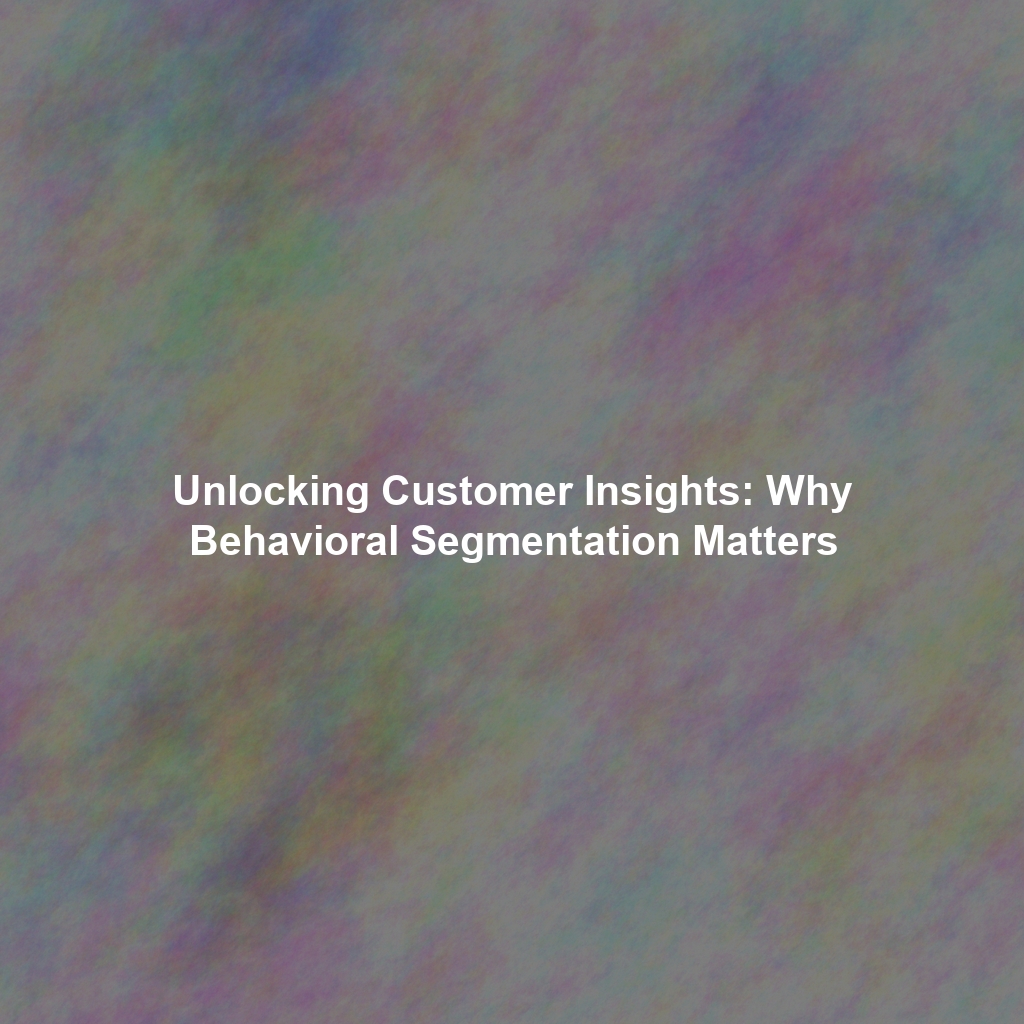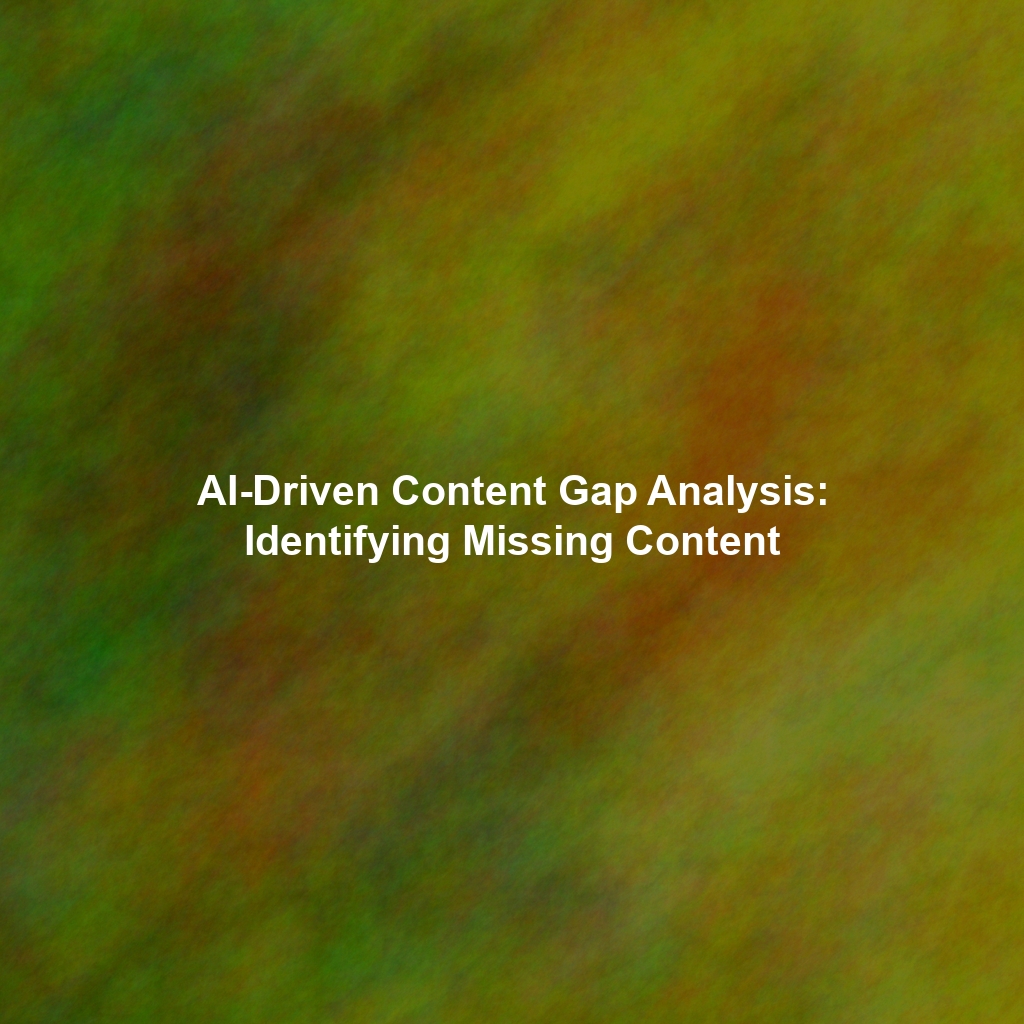Beyond Demographics: A Deep Dive into Customer Actions for Precision Marketing
In today’s fiercely competitive, data-rich marketplace, simply knowing basic demographic information about your customers is no longer sufficient to gain a significant competitive edge. To truly connect with your audience on a meaningful level, foster deep loyalty, and drive tangible, impactful results, you need to understand the underlying “why” behind their actions – why they behave the way they do. This is precisely where the strategic power of behavioral segmentation comes into play. It’s not just about who your customers are in terms of age or location, but fundamentally about *how* they interact with your brand, engage with your products, and consume your content across every touchpoint.
Traditional segmentation methods, such as demographic, geographic, or even basic psychographic segmentation, while useful for broad overviews, often lack the granular detail and actionable insights needed to create truly personalized, highly effective marketing experiences. Behavioral segmentation, on the other hand, revolutionizes this approach by grouping customers based on their observed, measurable behaviors. This provides a much richer, more dynamic understanding of their evolving needs, preferences, and intent. This data-driven approach allows you to tailor your marketing messages, product recommendations, and offers with unparalleled precision, leading directly to increased engagement, higher conversion rates, and a more efficient allocation of your marketing resources.
STRATEGIC IMPERATIVE:
Behavioral segmentation shifts marketing from broad strokes to laser-focused precision, enabling personalized experiences that resonate deeply and drive measurable results.
Beyond Demographics: A Deeper Dive into Customer Actions
While demographic and geographic segmentation provide a useful foundational overview of your customer base, they often fall short in providing the actionable insights necessary for hyper-personalization and truly effective marketing. Behavioral segmentation transcends these traditional boundaries by focusing on the tangible actions and interactions customers have with your brand. This approach provides a far richer, more dynamic, and ultimately more predictive understanding of their needs and preferences. By understanding *what* customers do, you can infer *why* they do it, and then strategically tailor your marketing messages and offers to resonate with specific groups, leading to significantly increased engagement and superior conversion rates.
This granular understanding allows businesses to move beyond generic campaigns. Instead of sending the same email to all customers, you can send targeted messages based on their recent website activity, past purchases, or even how they interact with your customer service. This level of relevance makes customers feel understood and valued, fostering a deeper connection with your brand.
The Pillars of Behavioral Segmentation: Key Categories for Comprehensive Understanding
Behavioral segmentation is a multifaceted discipline encompassing several key categories. A comprehensive understanding of each of these pillars allows you to construct a remarkably detailed and actionable profile of your customer’s behavior, enabling truly intelligent marketing strategies.
1. Purchase Behavior: Unveiling Buying Patterns and Intent
This is arguably one of the most directly impactful and crucial categories for revenue generation. Purchase behavior meticulously analyzes the various facets of how customers engage in transactions with your brand. Key factors to consider include:
- Frequency of Purchase: How often do customers buy your products or services? Are they frequent, habitual shoppers (e.g., weekly coffee buyers) or occasional, seasonal buyers (e.g., holiday gift purchasers)? This helps identify loyalty and potential for repeat business.
- Purchase Value (Monetary Value): How much do customers spend on each purchase, and over a given period? Are they high-value customers who consistently spend a significant amount, or do they typically make smaller, more budget-conscious purchases? This is critical for identifying your most profitable segments (e.g., using RFM analysis: Recency, Frequency, Monetary).
- Product/Service Usage & Preferences: Which specific products or services do customers use most often? Are they fiercely loyal to a particular line of products, or do they explore and experiment with different offerings? This informs cross-selling, upselling, and new product development.
- Purchase Channels: Where do customers prefer to make their purchases? Do they exclusively prefer online shopping via your website or app, frequent in-store visits, or a seamless combination of both (omnichannel behavior)? This optimizes channel investment.
- Payment Methods: What payment methods do customers prefer (e.g., credit cards, debit cards, mobile payment platforms, buy-now-pay-later services)? This can inform payment gateway optimization and personalized offers.
- Returns and Refunds Behavior: How often do customers return products or request refunds? While sometimes unavoidable, a high frequency can indicate potential issues with product quality, fit, or customer satisfaction, providing valuable feedback for product or service improvement.
Analyzing purchase behavior can reveal invaluable insights into customer preferences, spending habits, and loyalty levels. For example, identifying frequent shoppers who consistently purchase high-value items allows you to create highly targeted loyalty programs, offer exclusive discounts, or provide early access to new products, thereby maximizing their lifetime value.
2. Usage Behavior: How Customers Interact with Your Product or Service
This category delves into the specifics of *how* customers engage with and utilize your product or service post-purchase. Understanding usage behavior is particularly critical for SaaS companies, digital products, and subscription services. Consider the following key factors:
- Frequency of Use: How often do customers log in, open your app, or use your service? Are they daily, weekly, or occasional users? This helps identify active users versus those at risk of churn.
- Features Used: Which specific features or functionalities do customers actively utilize? Are they taking advantage of all the available advanced features, or are they primarily using a select few basic ones? This uncovers feature adoption gaps and opportunities for education.
- Time Spent Using: How much time do customers spend actively engaged with your product or service during each session or over a period? This can be a strong indicator of their level of engagement, perceived value, and overall satisfaction.
- User Journey within Product/App: How do customers navigate through your website or application? What specific steps do they take to complete a task or achieve a goal? Mapping this journey within the product helps optimize the user experience (UX) and identify friction points.
- Device Usage: Do customers primarily access your product via desktop, mobile app, or tablet? This informs responsive design efforts and platform-specific marketing.
Understanding usage behavior can help you pinpoint areas for product improvement, optimize the user experience, and provide highly targeted support or educational content. For example, if you notice that a significant segment of customers is not utilizing a particular, valuable feature, you can create targeted tutorials, in-app prompts, or offer incentives to encourage adoption, thereby increasing product stickiness and perceived value.
3. Occasion or Timing-Based Behavior: When and Why Customers Buy
This category examines the specific circumstances, events, or timeframes surrounding customer purchases or interactions. Understanding these temporal patterns allows for highly relevant and timely marketing campaigns. This includes:
- Seasonal Purchases: Do customers make purchases predominantly during specific seasons (e.g., summer apparel, winter sports equipment) or holidays (e.g., Valentine’s Day gifts, Black Friday deals)?
- Event-Driven Purchases: Do customers buy products or services in response to specific life events (e.g., birthdays, anniversaries, weddings, moving house) or external promotions (e.g., flash sales, product launches)?
- Recurring Purchases: Are there certain predictable times of the month or week when customers are more likely to make a purchase (e.g., grocery shopping on weekends, subscription renewals at month-end)?
- Time of Day/Week for Engagement: When are customers most active on your website, app, or email? This optimizes content delivery times.
Analyzing occasion or timing-based behavior is crucial for planning highly targeted marketing campaigns around specific events, holidays, or predictable customer needs. For example, you can offer special discounts during the holiday season, send personalized birthday greetings with exclusive offers, or launch targeted campaigns for back-to-school periods, ensuring your message is relevant to their current context.
4. Benefits Sought: Understanding Customer Motivations and Core Needs
This category transcends the “what” and “when” to delve into the “why” – the specific underlying benefits, values, or solutions that customers are seeking when they purchase a product or service. Understanding these motivations allows for powerful, value-driven messaging. This includes:
- Price Sensitivity: Are customers primarily motivated by the lowest price, or are they willing to pay a premium for higher quality, superior convenience, or enhanced features? This helps in pricing strategy and promotional targeting.
- Quality Expectations: What level of quality do customers expect from your product or service? Are they seeking basic functionality, durable reliability, or cutting-edge innovation and luxury?
- Convenience & Ease of Use: How important is convenience to your customers? Are they willing to sacrifice certain features for ease of use, faster delivery, or a simplified purchasing process?
- Problem Solving: What specific problems, pain points, or challenges are customers primarily trying to solve or alleviate with your product or service? This is often the core of their motivation.
- Status or Image: Are customers buying for social status, brand prestige, or to project a certain image? (e.g., luxury goods, designer brands).
Understanding the specific benefits sought by different customer segments allows you to tailor your marketing messages to highlight the precise advantages and value propositions that resonate most powerfully with each group. For example, you can emphasize the affordability and value of your product for price-sensitive customers, or highlight its superior quality, craftsmanship, and exclusive features for customers who prioritize premium products and prestige.
5. Loyalty Status: Recognizing and Rewarding Your Best Customers
This category meticulously classifies customers based on their demonstrated loyalty and commitment to your brand over time. Nurturing loyalty is often far more cost-effective than acquiring new customers. This includes:
- Brand Advocates/Evangelists: Customers who are not only highly loyal but also actively recommend your brand to others through reviews, social media, or word-of-mouth. These are your most valuable promoters.
- Repeat Customers: Customers who consistently make repeat purchases from your brand over time, indicating satisfaction and a preference for your offerings.
- New Customers/First-Time Buyers: Individuals who have just made their initial purchase. The focus here is on successful onboarding and encouraging a second purchase.
- Lapsed Customers/Churned Customers: Customers who have previously purchased from your brand but have not made a purchase in a significant while, or have actively stopped using a subscription service. These represent win-back opportunities.
- At-Risk Customers: Customers showing signs of disengagement (e.g., declining usage, decreased purchase frequency) who might soon lapse.
Segmenting customers based on their loyalty status allows you to implement highly targeted loyalty programs, exclusive rewards for your most valuable customers, and precisely timed re-engagement campaigns for those at risk or who have lapsed. For example, you can offer exclusive early access to new products for brand advocates or send personalized “we miss you” offers to lapsed customers to encourage their return.
6. User Status: Identifying Prospects and Customers Along the Funnel
This category classifies individuals based on their current interaction level or status within your brand’s ecosystem, from complete strangers to loyal patrons. Understanding this status is crucial for tailoring messaging to their stage in the marketing and sales funnel:
- Non-users/Aware: Individuals who have never interacted with your brand but might be aware of your existence. Marketing efforts focus on initial engagement and education.
- Prospects/Leads: Individuals who have expressed some level of interest in your brand (e.g., signed up for a newsletter, downloaded a resource, visited a pricing page) but haven’t yet purchased. These need nurturing strategies.
- First-time Buyers: Individuals who have just made their very first purchase from your brand. The focus here is on successful onboarding, encouraging product adoption, and driving a second purchase.
- Regular/Active Users: Individuals who consistently use your product or service and make repeat purchases. These customers are ripe for loyalty programs, upselling, and cross-selling.
- Defectors/Former Users: Individuals who have stopped using your brand or product. Identifying these allows for targeted win-back strategies to understand and address their reasons for leaving.
Understanding the user status of your audience is crucial for orchestrating precisely tailored marketing efforts. Non-users might require broad awareness campaigns, while prospects need targeted lead nurturing sequences. First-time buyers benefit immensely from robust onboarding experiences, and regular users appreciate exclusive loyalty rewards. Identifying defectors allows for strategic win-back campaigns aimed at understanding their reasons for leaving and enticing them to return.
Implementing Behavioral Segmentation: A Step-by-Step Guide for Action
Putting the powerful principles of behavioral segmentation into effective practice requires a systematic, data-driven approach. It’s not a one-time setup but an ongoing process of refinement. Here’s a comprehensive step-by-step guide to help you get started and ensure success:
1. Define Your Goals: What Do You Truly Want to Achieve?
Before you even begin the technical process of segmenting your audience, it is absolutely paramount to clearly and precisely define your strategic goals. What specific business outcomes do you aim to achieve with behavioral segmentation? Are you trying to significantly increase sales, improve customer retention rates, enhance brand loyalty, reduce churn, or perhaps optimize a specific product feature adoption? Clearly articulated, measurable goals will serve as your guiding star, helping you focus your efforts, prioritize your segmentation criteria, and accurately measure your ultimate success and ROI.
2. Collect Data: Gather Comprehensive Information About Customer Behavior
The next, critical step is to systematically collect robust and comprehensive data about customer behavior across all relevant touchpoints. This foundational data can be gathered through a variety of powerful methods and tools:
- Website Analytics: Leverage tools like Google Analytics, Adobe Analytics, or similar platforms to track granular website traffic, page views, user navigation paths, time on site, and conversion funnels. This reveals digital interaction patterns.
- CRM Systems: Your Customer Relationship Management (CRM) system (e.g., Salesforce, HubSpot, Zoho CRM) is a goldmine. It collects invaluable data on customer purchases, service interactions, communication history, and demographics, providing a unified customer view.
- Marketing Automation Platforms: Tools like Marketo, HubSpot Marketing Hub, or Pardot track email opens, clicks, website visits triggered by emails, form submissions, and content downloads, providing insights into engagement with your marketing efforts.
- Social Media Analytics & Listening: Monitor social media engagement (likes, shares, comments), brand mentions, sentiment, and follower demographics using native platform insights or third-party social listening tools.
- Customer Surveys & Feedback: Directly gather qualitative and quantitative feedback from customers about their experiences, preferences, motivations, and pain points through surveys, polls, and interviews.
- Transactional Systems: Data from POS (Point of Sale) systems, e-commerce platforms, and billing systems provides detailed purchase history, product preferences, and payment methods.
3. Analyze Data: Identify Actionable Patterns and Trends
Once you’ve collected a rich dataset, the next crucial step is to rigorously analyze it to identify meaningful patterns, emerging trends, and significant correlations. Look for connections between different behaviors and demographic or psychographic attributes. For example, you might discover that customers who frequently visit your “pricing” page but don’t convert are more likely to respond to a specific discount offer. Or, that users who engage with your video tutorials have higher product adoption rates. This analytical phase transforms raw data into actionable intelligence.
4. Create Segments: Group Customers Based on Shared Behaviors
Based on your in-depth analysis, proceed to create distinct segments of customers who exhibit similar behaviors and characteristics. For example, you might create a segment of “High-Value, Frequent Purchasers” who consistently buy premium products, or “Feature Explorers” who actively engage with new product functionalities. When defining your segments, strive for them to be mutually exclusive and collectively exhaustive (MECE) where possible. This ensures that each customer belongs to only one segment (avoiding overlap) and that all customers are accounted for (no gaps), leading to cleaner, more effective targeting.
5. Develop Targeted Strategies: Tailor Your Marketing Messages with Precision
Once your precise segments are defined, the real work of personalization begins. Develop highly targeted marketing strategies for each distinct group. This involves meticulously tailoring your marketing messages, content, offers, and even the channels you use to resonate directly with the specific needs, preferences, and behavioral triggers of each segment. The key is to communicate in a way that feels inherently relevant, personal, and valuable to the individual, rather than generic. For instance, a “lapsed customer” segment might receive a win-back offer, while a “new user” segment receives onboarding tutorials.
6. Test and Optimize: Continuously Improve Your Approach
Behavioral segmentation is not a static, one-time project; it’s an ongoing, iterative process of continuous improvement. You must continuously test and optimize your approach to ensure that your strategies are achieving your defined goals and delivering maximum ROI. Monitor the performance of your segmented marketing campaigns rigorously, using A/B testing for different messages or offers. Make agile adjustments as needed based on the data. Regularly review your defined segments, and update them based on new behavioral data, evolving customer preferences, or changes in market dynamics. This continuous feedback loop is essential for sustained success.
Benefits of Behavioral Segmentation: A Winning Strategy for Modern Marketing
The benefits of strategically implementing behavioral segmentation are numerous and far-reaching, transforming various aspects of your marketing and business operations. By truly understanding your customers’ behaviors, you can unlock a cascade of positive outcomes:
- Improved Customer Engagement: By delivering more relevant, personalized, and timely experiences, you capture customer attention more effectively, leading to higher open rates, click-throughs, and overall interaction with your brand.
- Increased Conversion Rates: Targeting the right customers with the right offers at the right time, based on their behavior and intent, significantly increases the likelihood of them completing a desired action, boosting your sales and lead generation.
- Boost Customer Loyalty & Retention: Personalized interactions make customers feel valued and understood, fostering stronger emotional connections with your brand. This translates directly into increased customer loyalty, repeat purchases, and reduced churn.
- Enhanced Marketing ROI & Efficiency: By optimizing your marketing spend and allocating resources to campaigns that are precisely tailored to specific, high-potential segments, you achieve better results with less waste, maximizing your return on investment.
- Drive Product Development & Innovation: Understanding customer usage behavior, benefits sought, and pain points provides invaluable insights for your product development teams. This data can inform feature prioritization, identify unmet needs, and drive innovation that truly resonates with your market.
- Better Sales Alignment: Providing sales teams with behavioral insights allows them to prioritize leads, tailor their pitches, and engage with prospects more effectively, leading to shorter sales cycles and higher close rates.
Examples of Behavioral Segmentation in Action: Real-World Success Stories
To bring the power of behavioral segmentation to life, let’s examine a few real-world examples of how businesses are successfully leveraging these insights to drive tangible results across various industries:
E-commerce Retailer: Personalizing Fashion Recommendations
An online clothing retailer utilizes purchase behavior data to identify customers who frequently buy dresses of a specific style or brand. Leveraging this insight, they then send these customers highly personalized emails featuring new arrivals, exclusive promotions, and curated collections specifically focused on dresses that align with their past purchase patterns. This targeted approach significantly outperforms generic promotional emails, leading to higher conversion rates and increased average order value from this segment.
Software Company: Boosting Feature Adoption and Retention
A SaaS (Software as a Service) company uses usage behavior to identify customers who have subscribed to their platform but are not actively utilizing a particular, valuable feature (e.g., a collaboration tool within a project management software). They then trigger an automated workflow that sends these specific customers a series of targeted email tutorials, in-app prompts, and even offers personalized support sessions to help them learn how to use the feature and unlock more value from the product. This proactive engagement leads to increased feature adoption, higher user satisfaction, and ultimately, improved customer retention rates.
Travel Agency: Timely Vacation Planning
A prominent online travel agency uses occasion-based behavior to identify customer segments who typically book their vacations during specific periods, such as families who travel during the summer months or couples who book romantic getaways around Valentine’s Day. Based on this historical data, they send these customers personalized emails featuring relevant vacation packages, travel deals, and destination guides precisely timed to align with their anticipated travel planning cycles. This ensures their offers are highly relevant and top-of-mind when customers are most receptive to booking.
Subscription Box Service: Curating for Core Values
A popular subscription box service leverages benefits-sought segmentation to identify customers who explicitly indicated (e.g., via a sign-up survey) that they are primarily interested in organic, sustainable, and ethically sourced products. For this specific segment, the service then curates a special, exclusive box featuring only organic and sustainable items, rather than their standard mix. This deep alignment with customer values creates a stronger emotional connection, higher satisfaction, and reduced churn within this high-value segment.
Online Learning Platform: Guiding Student Progress
An online learning platform uses user status and engagement behavior to identify students who have enrolled in a course but have not completed the first module within a set timeframe. They trigger an automated email sequence offering helpful tips, direct links to support resources, or even a personalized message from an instructor to encourage re-engagement. Conversely, students who rapidly complete modules receive emails with advanced topics or recommendations for their next course, ensuring continuous learning and satisfaction.
Conclusion: Embrace the Power of Behavioral Insights for Unprecedented Success
Behavioral segmentation is far more than just a marketing buzzword; it is a powerful, indispensable tool that can help you unlock profoundly valuable insights into your customers’ true needs, preferences, and motivations. By systematically understanding *how* your customers behave, *what* actions they take, and *why* they take them, you can move beyond generic mass marketing to create more personalized, engaging, and ultimately impactful experiences that drive tangible results. In a world where customers increasingly expect tailored interactions and relevant communication, embracing behavioral segmentation is no longer a luxury – it is an absolute necessity for achieving sustainable success and competitive differentiation.
The future of marketing belongs to those who understand their customers not just by who they are, but by what they do. Invest in the data, build your segments, and start delivering the personalized experiences that will convert prospects into loyal advocates. The insights are there, waiting to be leveraged for unprecedented growth.
 Skip to content
Skip to content

